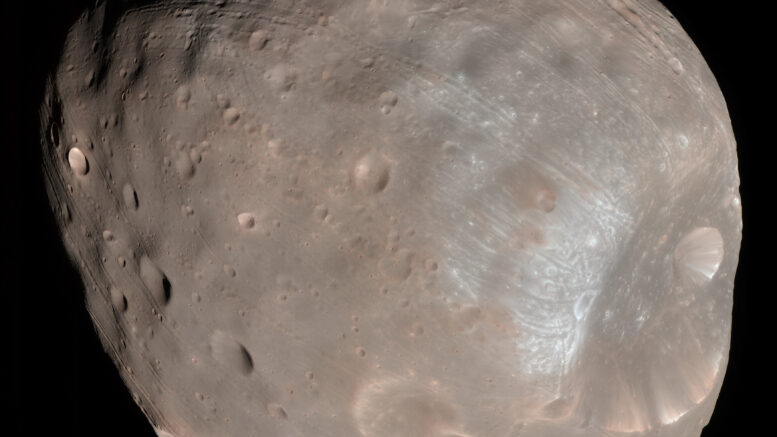In August 1877, the American astronomer Asaph Hall discovered the two moons of Mars using a 660 mm, 26 in, telescope at the U.S. Naval Observatory.[1] The names of the two satellites, Phobos and Deimos, were chosen by Hall based upon a suggestion by Henry Madan, a science instructor at Eton College in England.[2] Hall was abut to give up pursuit of the discovery of martian moons, but his wife persuaded him to continue, which led to the discovery of the moons shortly afterwards.
These moons are interesting as they have an irregular shape. They are named after the Greek mythological twin characters Phobos, which means panic or fear, and Deimos, which means terror or dread, who accompanied their father Ares into battle. Ares, god of war, was known to the Romans as Mars.
Phobos
Phobos is a small, irregularly shaped object with a mean radius of 11 kilometers or 7 miles [3] and is seven times as massive as the outer moon, Deimos. Phobos is named after the Greek god Phobos, a son of Ares (Mars) and Aphrodite (Venus) and the personification of fear. Phobos orbits 6,000 km (3,700 mi) from the Martian surface, closer to its primary body than any other known planetary moon.
The moon orbits Mars so close that the time it take to orbits is actually much faster than Mars rotates, and completes an orbit in just 7 hours and 39 minutes. As a result, from the surface of Mars it appears to rise in the west, move across the sky in 4 hours and 15 minutes or less, and set in the east, twice each Martian day. Phobos is one of the least reflective bodies in the Solar System, with an albedo of just 0.071.
Surface temperatures range from about −4 °C on the sunlit side to −112 °C on the shadowed side.[4] The defining surface feature is the large impact crater, Stickney, which takes up a substantial proportion of the moon’s surface. In November 2018, astronomers concluded that the many grooves on Phobos were caused by boulders ejected from the asteroid impact that created Stickney and rolled around on the surface of the moon.[5] There is an alternative theory is that the grooves on Phobos are stretch marks caused by tidal forces.
Images and models indicate that Phobos may be a rubble pile held together by a thin crust, and that it is being torn apart by tidal interactions. [6] Phobos gets closer to Mars by about 2 meters every one hundred years; therefore, it is predicted that within 30 to 50 million years Phobos will either collide with Mars, or break up into a planetary ring.[4]
Deimos
Deimos is the smaller and outermost of the two natural satellites of the planet Mars, the other being Phobos. Deimos has a mean radius of 6.2 km and takes 30.3 hours to orbit Mars.[7]
Deimos is 23,460 km from Mars, much further than Mars’s other moon, Phobos.[8] It is named for Deimos, who in Greek mythology is the twin brother of Phobos, and personifies terror. Only two geological features on Deimos have been given names. The craters Swift and Voltaire are named after writers who speculated on the existence of two Martian moons before Phobos and Deimos were discovered.[9]
Deimos’s orbit is nearly circular and is close to Mars’s equatorial plane. Deimos is possibly an asteroid that was perturbed by Jupiter into an orbit that allowed it to be captured by Mars, though this hypothesis is still controversial and disputed. Unlike Phobos, which orbits so fast that it rises in the west and sets in the east, Deimos rises in the east and sets in the west. The Sun-synodic orbital period of Deimos of about 30.4 hours exceeds the Martian solar day of about 24.7 hours by such a small amount that 2.48 days elapse between its rising and setting for an equatorial observer. From Deimos-rise to Deimos-rise, 5.466 earth days elapse. Because Deimos’s orbit is relatively close to Mars and has only a very small inclination to Mars’s equator, it cannot be seen from Martian latitudes greater than 82.7°. Deimos’s orbit is slowly getting larger, because it is far enough away from Mars and because of tidal acceleration. It is expected to eventually escape Mars’s gravity.[10]
Potential Exploration
There have been several missions that have been proposed, but none really have been too successful. The USSR did send a probe to Phobos and Deimos, with only 1 of the 2 probes returning photos. There have been other proposed missions by space agencies such as NASA, but all have been not moved forward to reality due to a number of reasons.
Sources And Further Reading
https://solarsystem.nasa.gov/moons/mars-moons/in-depth/
Check out the Planetary Bodies Category for previous and upcoming articles on the solar system planets.
[1] = Gingerich, Owen (1970). “The satellites of Mars: prediction and discovery”. Journal for the History of Astronomy. 1 (2): 109–115. Bibcode:1970JHA…..1..109G. doi:10.1177/002182867000100202.
[2] = “Obituary: Sir Joseph Henry Gilbert”. Journal of the Chemical Society. 81: 628–629. 1902. doi:10.1039/CT9028100625.
[3] = “Mars: Moons: Phobos”. NASA Solar System Exploration. 30 September 2003.
[4] = “NASA – Phobos”. Solarsystem.nasa.gov. Archived from the original on 24 June 2014.
[5] = Gough, Evan (20 November 2018). “Strange Grooves on Phobos Were Caused by Boulders Rolling Around on its Surface”. Universe Today.
[6] = “Phobos is Slowly Falling Apart”. NASA. SpaceRef. 10 November 2015.
[7] = “HORIZONS Web-Interface”. NASA. 21 September 2013.
[8] = Staff (2016). “Deimos”. SeaSky.org. Retrieved 23 January 2016.
[9] = of Planetary Nomenclature, USGS Astrogeology Research Program
[10] = https://www.space.com/20345-deimos-moon.html Deimos: Facts About the Smaller Martian Moon

Be the first to comment on "Moons of Mars"